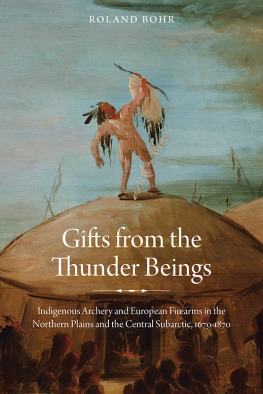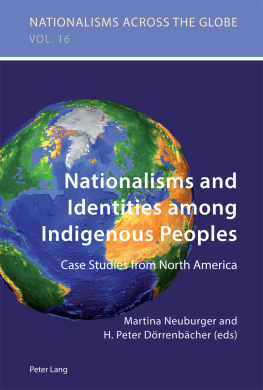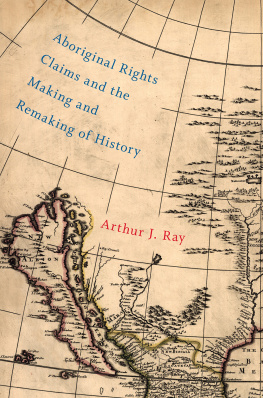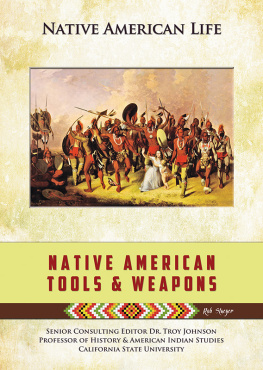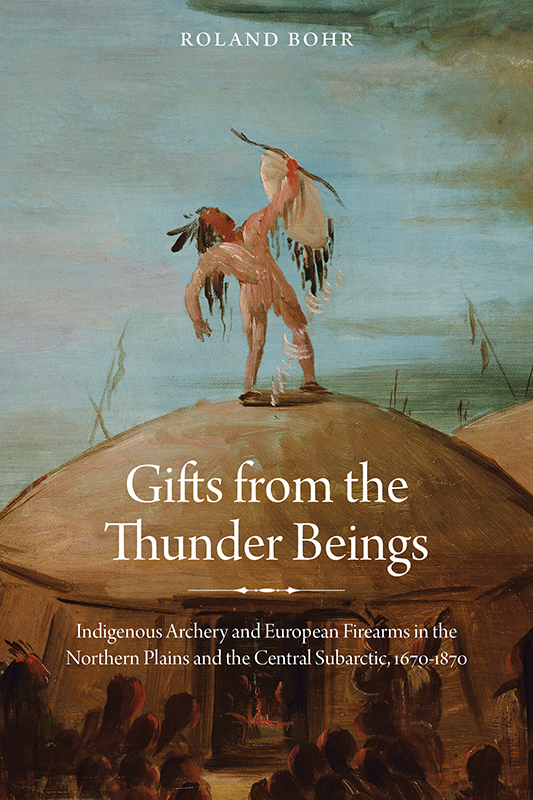
Aboriginal weapons are an important subject in themselves and for their role within Native societies and Native-white relations. Roland Bohrs knowledge of how Aboriginal weapons work and why they were constructed as they were allows the author to critique the ethnocentric and technologically ignorant assumptions of many earlier scholars. As a bowyer himself, Bohr brings knowledge of making and using bows and arrows lacking in earlier scholarship to his careful historical research.
Dr. Laura Peers, curator of the Americas at the Pitt Rivers Museum and reader in the School of Anthropology and Museum Ethnography at the University of Oxford
Gifts from the Thunder Beings
Gifts from the Thunder Beings
Indigenous Archery and European Firearms in the Northern Plains and Central Subarctic, 16701870
Roland Bohr
University of Nebraska Press
Lincoln and London
2014 by the Board of Regents of the University of Nebraska
Cover image: George Catlin, Rainmaking among the Mandan, from the Smithsonian American Art Museum, gift of Mrs. Joseph Harrison Jr.
All rights reserved
Library of Congress Cataloging-in-Publication Data
Bohr, Roland.
Gifts from the thunder beings: indigenous archery and European firearms in the Northern Plains and Central Subarctic, 16701870 / Roland Bohr.
pages cm.
Includes bibliographical references and index.
ISBN 978-0-8032-4838-0 (cloth: alk. paper)
ISBN 978-0-8032-5438-1 (epub)
ISBN 978-0-8032-5439-8 (mobi)
ISBN 978-0-8032-5437-4 (pdf)
1. Indian weaponsGreat PlainsHistory. 2. Indian weaponsCanada, NorthernHistory. 3. Bow and arrowGreat PlainsHistory. 4. Bow and arrowCanada, NorthernHistory. 5. FirearmsGreat PlainsHistory. 6. FirearmsCanada, NorthernHistory. I. Title.
E 98. A 65 B 64 2014
355.8'241dc23
2013039217
The publisher does not have any control over and does not assume any responsibility for author or third-party websites or their content.
Contents
Illustrations
Figures
Maps
Table
Preface
This study examines North American Aboriginal peoples use of Indigenous and European distance weapons in big game hunting and combat from the beginning of the fur trade in the Hudsons Bay Company trading territory in the late seventeenth century to the treaty and reserve period that began in Canada in the 1870s. It compares the northern Great Plains and the Central Subarctic, two adjacent but environmentally very different regions of North America and their respective Indigenous cultures.
Technological change and the impacts of European contact were not uniform throughout North America. Aboriginal people in the Northern Plains and Central Subarctic became much involved in the fur trade and from the early 1700s on had to deal with European newcomers, but they did so in divergent ways. Because Aboriginal people in both regions were affected by and participated in the fur trade, a comparative examination of continuity and change in their hunting methods and hunting equipment, as well as patterns of violent conflict, can shed more light on their history and the history of Aboriginal-European relations. Wherever possible, this examination focuses closely but not exclusively on the Omushkego (Swampy) Cree, exemplifying Central Subarctic Aboriginal peoples and on the Blackfoot as an exemplary Aboriginal group from the Northern Plains. The Omushkego Cree were chosen because they had a relatively long and quite early exposure to the fur trade and the changes it brought. The Blackfoot provide a good example of Plains cultures because their acquisition of horses and firearms was said to have been a crucial factor in their westward and southward expansion, causing important shifts in military and political relations between Aboriginal peoples in the Northern Plains.
My interest in North American Aboriginal peoples history began with a fascination with their material culture. Intrigued by the controversies surrounding the relative effectiveness of Aboriginal technologies in comparison to European tools and weapons, I found that much of the sparse information on Aboriginal weapons was either overlooked or misinterpreted by historians of the fur trade. To gain a more realistic understanding of their capabilities, I began in 1992 to manufacture working reproductions of Aboriginal artefacts such as moccasins, containers, tools, and bows and arrows. Through a Fulbright Grant at the University of North Dakota in Grand Forks in 199596, I had the chance to study the history, archaeology, and material culture of the Mandan, Hidatsa, Arikara, and Lakota. There, I began to seek information from Aboriginal people themselves in order to compare it with information from other sources and to integrate it into my practical studies on Aboriginal material culture.
Soon after I began my doctoral studies at the University of Manitoba in Winnipeg in 1999, I met Mr. Louis Bird, an Omushkego (Swampy Cree) elder from Peawanuck, Ontario, who had been active in collecting his peoples traditions, legends, and histories for over thirty years. My conversations and cooperation with Louis Bird had a formative influence on my work. So far my interests had been mainly directed toward Plains Aboriginal peoples, but he brought me to study Subarctic peoples as well. Through these conversations I realized that a significant amount of information on traditional Subarctic Aboriginal archery has survived in Omushkego-Cree oral traditions and through peoples continued use of bows and arrows in hunting. But because of a widespread assumption that traditional weaponry had quickly disappeared after the opening of direct trade between the coastal Cree and the Hudsons Bay Company in 166869, academic researchers had never before asked Omushkego historians like Louis Bird about these topics.
Another realization that came from working with Louis Bird was that Subarctic peoples responses to European tools and weapons and their ways of integrating these new items into their own technology, although appearing similar on the surface, were very different from those of Aboriginal groups in the Northern Plains. Comparing these different Aboriginal cultures in regard to their usage of Indigenous and European technology has led me to a more thorough understanding of these adaptive processes and Aboriginal peoples responses to them.
A brief survey of the Subarctic and Northern Plains environments and the most common subsistence strategies in these regions near the time of contact (chapter 2) provides the context for a detailed examination of Aboriginal distance weapons in chapters 3 and 4. Chapter 4 also examines social and cultural aspects of the manufacture of arrows. Chapter 5 introduces the major types of firearms that became available to Aboriginal people through the fur trade. Its main focus is on muzzle-loading smoothbore flintlock guns because these comprised the majority of firearms sold in the fur trade and because these weapons, rather than later models of repeating firearms, were said to have had an important impact on military relations among different Aboriginal groups in the Plains and Subarctic. Chapter 6 compares injuries from arrows and bullets, and chapter 7 explores some of the social and spiritual connotations of bows, arrows, quivers, and firearms.
Beyond the capabilities of European weapons, Aboriginal peoples ways of adapting and using them contributed greatly to the impact these weapons had on Aboriginal cultures. Chapter 8 examines Aboriginal peoples use of archery and firearms in hunting, and chapters 9 and 10 compare and contrast important aspects of their use in combat in the Central Subarctic and Northern Plains. Following the conclusion in chapter 11, a glossary of archery terms defines the technical archery terms and concepts appearing in this study.
Next page
